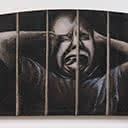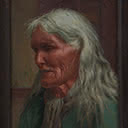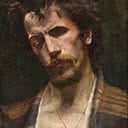Sophia
19 x 14 cm
est. $450,000 - 650,000
PROVENANCE
Private Collection, Auckland
Acquired 1912 by the current owner, by descent Guide Sophia Hinerangi was the principal tourist guide of the Pink and White Terraces at Lake Rotomahana. Following their destruction during the Tarawera eruption of 1886 she became a guide at nearby Whakarewarewa, Rotorua. Guide Sophie, as she was widely known, was well educated and bi-lingual. She introduced thousands of visitors to the beauty of the Terraces, acknowledged by Mark Twain as the eighth wonder of the world. Sophia was born in Kororareka in the early 1830s. Her mother, Kotiro Hinerangi, was a Ngati Ruanui woman who had possibly been captured by a Nga Puhi raiding party. Kotiro married Alexander Grey (or Gray), a Scotsman who had arrived in the Bay of Islands in 1827. Mary Sophia Gray was baptised by William Williams at Kororareka in 1839. It is thought that Sophia was raised by Charlotte Kemp at the Kerikeri mission station before attending the Wesleyan Native Institution at Three Kings, Auckland. In 1851 Sophia married her first husband, Koroneho (Colenso) Tehakiroe, with whom she had fourteen children. Following her second marriage, to Hori Taiawhio in 1870, she had a further three children. Tuhourangi tohunga, interpreted the devastating Tarawera eruption as a warning and reflected that the exploitation of the terraces as a tourist attraction showed scant regard for ancestral values. Guide Sophia herself saw these omens as a sign that her time as a guide at Rotomahana was drawing to a close. On 10 June 1886, the night of the eruption, over sixty people took shelter in Sophia's whare at Te Wairoa. Unlike many of the buildings in the village her home withstood the destructive power of the eruption due to its highpitched roof and strong reinforced timber walls. Tuhoto Ariki also survived the eruption and was dug from his buried house four days later. Sophia continued her work as a guide when she moved to nearby Whakarewarewa. In 1895 she joined George Leitch's Land of the Moa Dramatic Company, playing herself on a tour of Australia. In 1896 she was appointed caretaker of the Whakarewarewa Thermal Reserve. A number of royal parties were amongst the many thousands of visitors that Guide Sophia led through Whakarewarewa. She encouraged a number of local women to become guides, helping to establish this occupation as a lucrative form of employment for Tuhourangi women. Sophia was also deeply involved in the New Zealand Women's Christian Temperance Union, becoming president of the Whakarewarewa branch in 1896. Remembered as a leading light of her generation and a unique personality, Sophia fostered friendship between Maori and Pakeha and showed great courage in adversity. She was a friend and favoured subject the artist C F Goldie. Guide Sophia died at Whakarewarewa on 4 December 1911.
Through his lifetime and legacy Charles Frederick Goldie greatly influenced our nation's artistic and cultural consciousness. Born in Auckland on 20 October 1870, one of eight children from the marriage of Maria Partington and David Goldie, he was named after his maternal grandfather, Charles Frederick Partington, builder of the landmark Auckland windmill.
In 1883 the young Goldie was enrolled at Auckland Grammar School. His youthful artistic talents shone and it was not long before he was winning prizes at the Auckland Society of Arts. On leaving school Louis John Steele became his mentor and tutor. Two of the young artist's still life paintings so impressed Sir George Grey that he convinced David Goldie to allow his 22 year old son to attend the Académie Julian in Paris. Goldie spent over four years at the Académie Julian tutored by leading lights of the Paris Salon such as William-Adolphe Bouguereau. In 1898, fully informed in the French academic style, the artist returned to New Zealand and began collaborating with his former tutor Louis John Steele. The two worked on a number of paintings including The Arrival of the Maoris in New Zealand, a large scale history painting after Gericault's Raft of the Medusa. Before long, however, the relationship deteriorated likely caused by tensions around the former student's growing success. Goldie went on to open his own studio and establish himself as a successful portraitist of Maori.
A visit to Rotorua in 1901 was the first of several field trips during which the artist was introduced to local Maori and persuaded them to sit for portraits. Goldie's works from this point forward strongly reflect the European tradition in which he was trained, and possess a stunning power and visual clarity. On the one hand his remarkable dedication to realism belies an ethnographic interest, at the same time he was also striving to capture the mana of his sitters who included chiefs, tohunga and kaumatua. Goldie formed long-standing relationships with several Maori he met and painted around this period, including Wiremu Patara Te Tuhi and Te Aho-o-te-rangi Wharepu (Ngati Mahuta), Ina te Papatahi (Nga Puhi), and Wharekauri Tahuna (Ngati Manawa).
Over the next two decades Goldie gained national and international acclaim and steady demand formed a strong market for his portraits. A number of which would later be exhibited at the Royal Academy of Arts in London and the Paris Salon throughout the 1930s. In 1920 the artist moved to Sydney, where despite original plans to continue on to Paris, he was married, at age fifty to thirty five year old Olive Cooper. Marriage in Sydney circumvented the Goldie family disapproval of the relationship between Auckland's famous artist and the milliner from Karangahape Road. After two years in Sydney, apparently disillusioned with his work at this time and suffering from health problems Charles and Olive returned to New Zealand. Goldie's return to Auckland in 1924 ultimately represented a moment of artistic reckoning. Goldie received encouragement to resume painting from Governor General Lord Bledisloe. Devoting himself once again to his work he began to apply a more liberal, impressionistic approach to the realisation of his portraits and repainted a number of his former subjects. Works from this later period are distinguished by their soft luminescence, offering a rhythmic departure and disconnection from the rigours of formalism to which he had so strictly adhered in the past.
Goldie died in Auckland in 1947, his exquisite, spirituallycharged, often unsettling and ever powerful portraits of Maori having made an unsurpassed contribution to the history of art in New Zealand.





